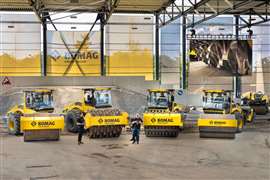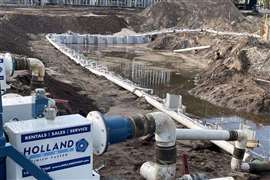Decarbonising construction in infrastructure - an industry view
19 June 2023
Construction matters and makes up around 13% of the world’s economy.
 Photo: Shell Construction and Road
Photo: Shell Construction and Road
Construction matters and makes up around 13% of the world’s economy.
It supports countless other sectors through the infrastructure it builds while facilitating security, health and education through energy networks, homes, roads, hospitals, and schools.
Yet, when it comes to the energy transition, for most of society, there is a reasonable chance that they would view emissions they can see from the world around them – planes or cars, maybe a power station or factory – as being top of the list to address.
Construction, and the emissions associated with developing critical infrastructure and industrial projects, is probably not the first thing that comes to mind. There is a disconnect between the construction of buildings and infrastructure, and the people that use them every day.
The result is that a key piece of the puzzle, embodied carbon – emissions coming from sourcing and producing materials, logistics, construction activities, maintenance, demolition, and waste management – is missing in efforts to decarbonise the world economy.
These emissions are hard to abate and have gone relatively unnoticed as the sector focuses its efforts on reducing the emissions coming from the operational phase. This must change.
Shining a light on embodied carbon
 Drone view of road construction in northern England. Photo: Shell Construction and Road
Drone view of road construction in northern England. Photo: Shell Construction and Road
The first aspect of embodied carbon that must be acknowledged is its scale. Based on the report Decarbonising Construction: Building a Low-Carbon Future recently launched by Shell, together with Deloitte, embodied carbon emissions in the construction sector accounted for 5.4 gigatonnes of carbon dioxide (Gt CO2) in 2020. This is 16% of all global CO2 emissions – equivalent to five times a major sector like aviation.
The report, which shares the views and perspectives of nearly 100 European, North American, and Asian senior construction executives and experts across the value chain, also offers practical solutions to significantly reduce the embodied carbon in construction.
It also outlines that there is confidence in the opportunities afforded by new and existing decarbonisation technologies, whether expanding investment in low-carbon cement and concrete, scaling low-carbon steel production, or adopting and scaling the use of alternative materials.
There is clear evidence these can be accelerated by the industry coming together to aggregate demand, alongside supportive regulation and systems thinking.
That is not to say there are no challenges; ineffective procurement practices, insufficient regulation and no established standards for data, methodologies and tools to measure embodied carbon are all areas where progress is needed.
In tackling these, the report identifies several immediate practical steps that the sector can work together to take on today.
 Raman Ojha, vice president, Shell Construction and Road. Photo: Shell
Raman Ojha, vice president, Shell Construction and Road. Photo: Shell
Asset owners and commissioners of major construction projects can help to encourage the development and use of decarbonisation technologies and low-carbon solutions.
Sharing best practices across the sector will be essential to ensuring that new tools and ways of working are scaled quickly.
Investors can also create new incentives around financing standards and investment in lower-carbon construction projects.
The vital role of infrastructure
The report also identifies areas where real progress is being made, highlighting that infrastructure construction projects are likely to decarbonise at the fastest pace compared with buildings or industrial projects.
Linked to an earlier point, asset owners setting direction and expectations on decarbonisation and asking for the use of more low-carbon solutions in road construction projects stimulate the development of decarbonised approaches.
At the same time, investment in energy infrastructure is also vital. Without a rapidly developed and reliable supply of renewable energy, alongside energy transportation, supply and storage infrastructure, decarbonisation of construction will remain a challenge beyond 2050.
But when investment in energy infrastructure is accompanied by strong central direction from governments and asset owners, there are wider economic benefits.
Materials manufacturers and companies involved in construction processes seeking to meet the decarbonisation ambitions will consider their location according to the availability of low-carbon energy.
Time for action
The scale of the task to reduce embodied carbon in construction cannot be overstated.
A more collaborative mindset and approach across the sector, as well as a willingness to trial new technologies and ways of doing business, all have the potential to make a real difference.
Above all, I hope that this report has shown that with bold and decisive action, this difference can be made starting today.
Everyone across the value chain has an important role to play, and we are ready to work with partners across the industry to develop low-carbon construction solutions and encourage more decarbonisation initiatives.
Together, we can meet the ambitions of both today and tomorrow.
You can read “Decarbonising Construction: BUILDING A LOW-CARBON FUTURE” here.
STAY CONNECTED



Receive the information you need when you need it through our world-leading magazines, newsletters and daily briefings.
CONNECT WITH THE TEAM











